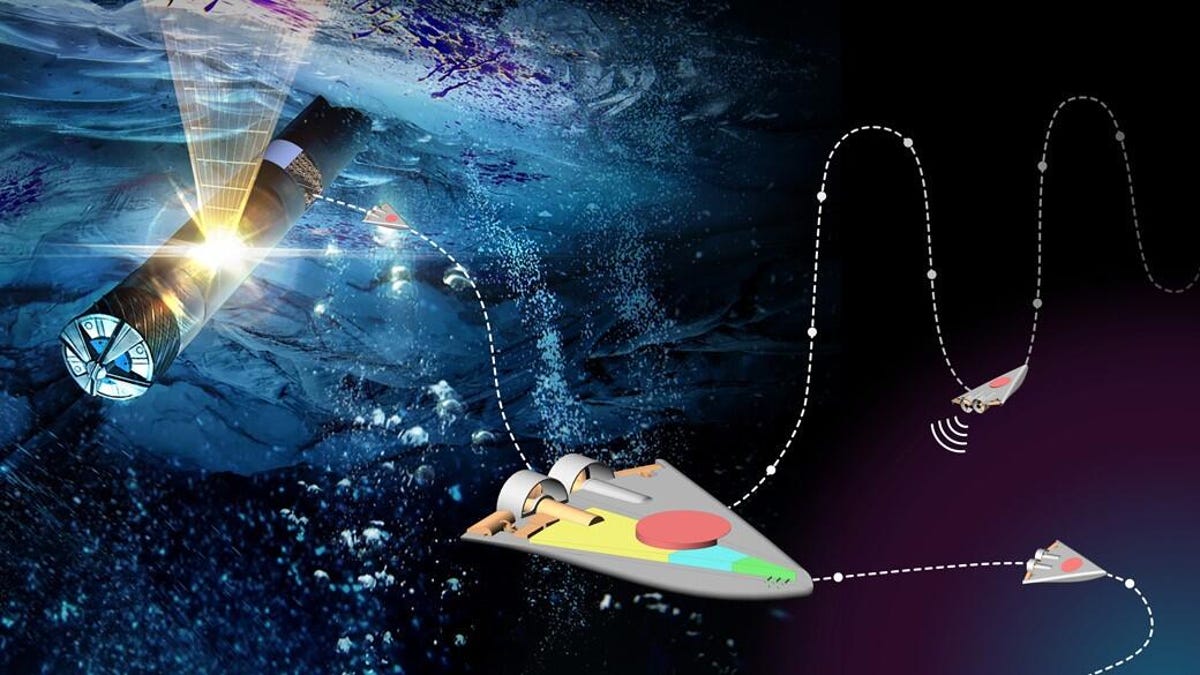NASA Working on Robots to Search Other Worlds for Underwater Aliens

In the Sensing With Independent Micro-Swimmers (SWIM) concept, illustrated here, dozens of small robots would descend through the icy shell of a distant moon via a cryobot – depicted at left – to the ocean below.
What's happening
NASA is developing small robots to swim the subsurface seas of other worlds.
Why it matters
Moons in our solar system, like Europa around Jupiter or Saturn's Enceladus, harbor hidden oceans thought to be worthy of checking for alien life.
What's next
The space agency is funding development and testing of a low-cost prototype.
Some of the most promising places to look for alien life beyond Earth are the hidden oceans that lie beneath thick icy shells on other worlds like Saturn's moon Enceladus. NASA is funding research to develop tiny, swimming robots that could search these darkened depths for marine extra-terrestrials.
Plumes of liquid water erupt into space through fissures in Enceladus's frozen surface and when NASA's Cassini spacecraft flew through that cosmic mist, it detected interesting molecules that are often associated with the presence of life, like methane.
NASA engineer Ethan Schaler has developed a concept involving an ice-melting probe and a school of cell phone-size aquatic drones to explore such eerie environments. It's called Sensing With Independent Micro-Swimmers (SWIM), and it has recently received funding to create and test 3D-printed prototypes.
"With a swarm of small swimming robots, we are able to explore a much larger volume of ocean water and improve our measurements by having multiple robots collecting data in the same area," Schaler said in a statement.
The project has recently received $600,000 in a second round of funding from the NASA Innovative Advanced Concepts program. Known as SWIM, the project was also previously awarded $125,000 in phase one NIAC funds to conduct a feasibility study and come up with a design.
The triangular swimming robots could be loaded into a larger "cryobot" design that tunnels its way through the ice by melting it, perhaps using radiation. Cryobot concepts are currently in development through other NASA programs.
Current cryobot designs have the probe tethered to a lander on the surface for communications and control. SWIM team scientist Samuel Howell says the tiny swimmers could greatly extend the reach of the probe in the same way that NASA's Ingenuity helicopter increased the range of the Perseverance mission on Mars.
"What if, after all those years it took to get into an ocean, you come through the, ice shell in the wrong place? What if there's signs of life over there but not where you entered the ocean?" Howell said. "By bringing these swarms of robots with us, we'd be able to look 'over there' to explore much more of our environment than a single cryobot would allow."
It will be some time before the little bots could touch an alien ocean. The concept isn't currently attached to any NASA mission to such a world. But the upcoming Europa Clipper mission to the Jovian moon of the same name will certainly provide valuable data from another frozen world hiding a subterranean sea. It launches in 2024 with a planned arrival at Europa in 2030.

